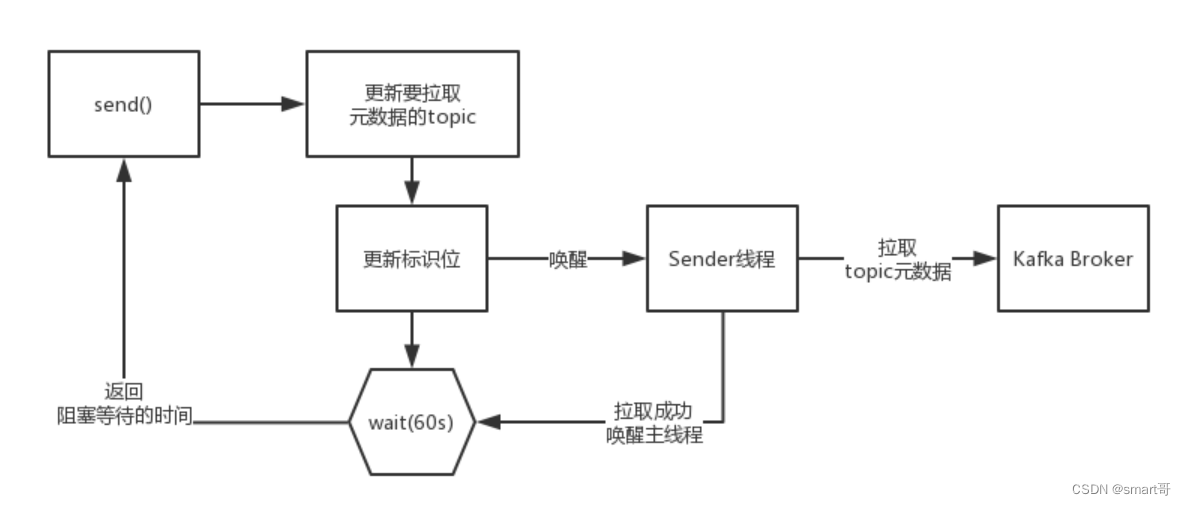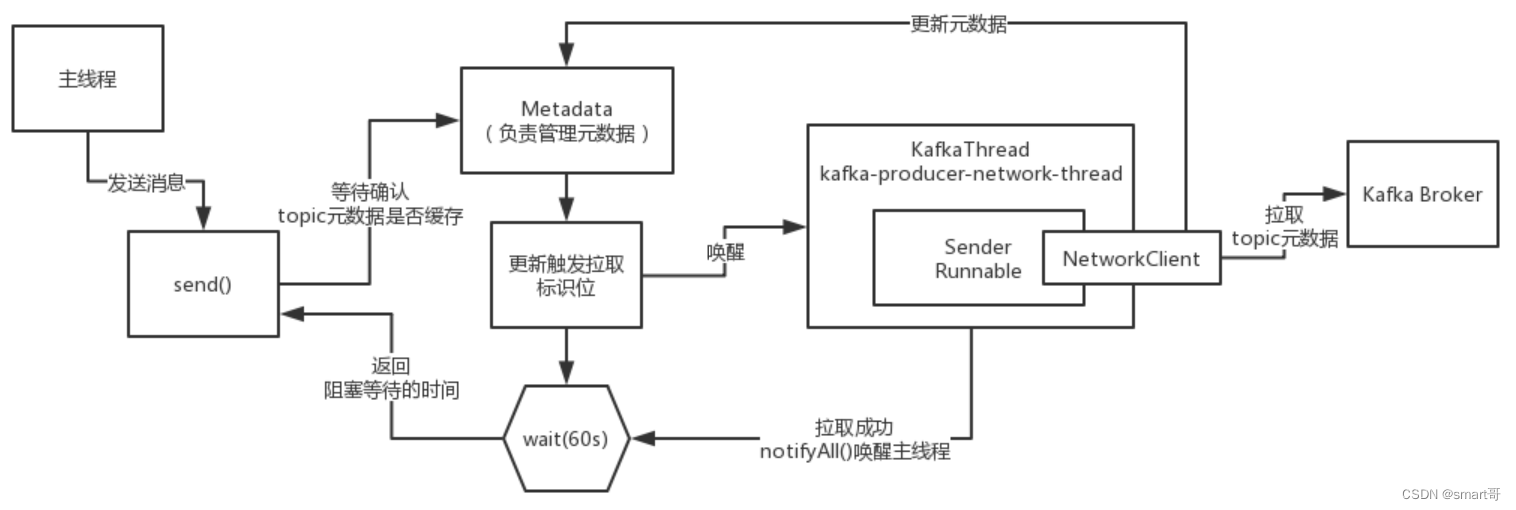作者简介:大家好,我是smart哥,前中兴通讯、美团架构师,现某互联网公司CTO
联系qq:184480602,加我进群,大家一起学习,一起进步,一起对抗互联网寒冬
学习必须往深处挖,挖的越深,基础越扎实!
阶段1、深入多线程
阶段2、深入多线程设计模式
阶段3、深入juc源码解析
码哥源码部分
码哥讲源码-原理源码篇【2024年最新大厂关于线程池使用的场景题】
码哥讲源码-原理源码篇【揭秘join方法的唤醒本质上决定于jvm的底层析构函数】
码哥源码-原理源码篇【Doug Lea为什么要将成员变量赋值给局部变量后再操作?】
码哥讲源码【谁再说Spring不支持多线程事务,你给我抽他!】
打脸系列【020-3小时讲解MESI协议和volatile之间的关系,那些将x86下的验证结果当作最终结果的水货们请闭嘴】
KafkaProdcuer在发送消息时,需要指定消息的Topic,但实际发送消息时一定是会发送到某个Broker中的。那么,Producer就必须知道Broker集群的元数据信息,比如有哪些Topic,这些Topic都有哪些分区,每个分区在哪个Broker上等等。
本章,我就来讲解KafkaProducer内部是如何保存和更新集群元数据信息的。我们将了解,对集群元数据的客户端缓存,Kafka是如何根据不同的需求、使用和场景,采用不同的数据结构来进行存放的,这也是我们需要重点关注的地方。
一、元数据结构
KafkaProducer在构造时,有这么几行代码:
// 1.创建Metadata对象
this.metadata = new Metadata(retryBackoffMs, config.getLong(ProducerConfig.METADATA_MAX_AGE_CONFIG), true, clusterResourceListeners);
// 2.解析Broker地址
List<InetSocketAddress> addresses = ClientUtils.parseAndValidateAddresses(config.getList(ProducerConfig.BOOTSTRAP_SERVERS_CONFIG));
// 3.更新元数据
this.metadata.update(Cluster.bootstrap(addresses), Collections.<String>emptySet(), time.milliseconds());
首先,KafkaProducer创建了一个MetaData对象;
接着,根据我们自己配置的bootstrap.servers地址,创建一个Cluster对象——Cluster.bootstrap(addresses);
最后,调用MetaData.update()进行元数据的更新。
1.1 MetaData元数据
我们来看下MetaData到底是个什么东西?从字段定义可以看出来,它内部就是保存了一些Topic的更新策略,同时封装了一个Cluster对象。也就是MetaData只是一个壳,仅仅定义了元数据的更新策略,真正的元数据信息保存在Cluster对象中:
public final class Metadata {
public static final long TOPIC_EXPIRY_MS = 5 * 60 * 1000;
private static final long TOPIC_EXPIRY_NEEDS_UPDATE = -1L;
private final long refreshBackoffMs;
private final long metadataExpireMs;
private int version;
private long lastRefreshMs;
private long lastSuccessfulRefreshMs;
private Cluster cluster;
private boolean needUpdate;
private final Map<String, Long> topics;
private final List<Listener> listeners;
private final ClusterResourceListeners clusterResourceListeners;
private boolean needMetadataForAllTopics;
private final boolean topicExpiryEnabled;
public Metadata(long refreshBackoffMs, long metadataExpireMs, boolean topicExpiryEnabled, ClusterResourceListeners clusterResourceListeners) {
this.refreshBackoffMs = refreshBackoffMs;
this.metadataExpireMs = metadataExpireMs;
this.topicExpiryEnabled = topicExpiryEnabled;
this.lastRefreshMs = 0L;
this.lastSuccessfulRefreshMs = 0L;
this.version = 0;
this.cluster = Cluster.empty();
this.needUpdate = false;
this.topics = new HashMap<>();
this.listeners = new ArrayList<>();
this.clusterResourceListeners = clusterResourceListeners;
this.needMetadataForAllTopics = false;
}
//...
}
KafkaProducer在初始化时,调用了Metadata的update方法,这个方法是加锁的,也就是说每次只能有一个线程执行更新操作:
public synchronized void update(Cluster cluster, Set<String> unavailableTopics, long now) {
this.needUpdate = false;
this.lastRefreshMs = now;
this.lastSuccessfulRefreshMs = now;
this.version += 1;
if (topicExpiryEnabled) { // 是否允许Topic元数据过期,默认true
for (Iterator<Map.Entry<String, Long>> it = topics.entrySet().iterator(); it.hasNext(); ) {
Map.Entry<String, Long> entry = it.next();
long expireMs = entry.getValue();
if (expireMs == TOPIC_EXPIRY_NEEDS_UPDATE)
entry.setValue(now + TOPIC_EXPIRY_MS);
else if (expireMs <= now) {
it.remove();
log.debug("Removing unused topic {} from the metadata list, expiryMs {} now {}", entry.getKey(), expireMs, now);
}
}
}
// 回调监听器
for (Listener listener: listeners)
listener.onMetadataUpdate(cluster, unavailableTopics);
String previousClusterId = cluster.clusterResource().clusterId();
if (this.needMetadataForAllTopics) {
this.needUpdate = false;
this.cluster = getClusterForCurrentTopics(cluster);
} else {
this.cluster = cluster;
}
// The bootstrap cluster is guaranteed not to have any useful information
if (!cluster.isBootstrapConfigured()) {
String clusterId = cluster.clusterResource().clusterId();
if (clusterId == null ? previousClusterId != null : !clusterId.equals(previousClusterId))
log.info("Cluster ID: {}", cluster.clusterResource().clusterId());
clusterResourceListeners.onUpdate(cluster.clusterResource());
}
// 唤醒其它阻塞线程
notifyAll();
log.debug("Updated cluster metadata version {} to {}", this.version, this.cluster);
}
上述代码并没有真正去Broker获取元数据信息,而是简单的做了一个最最基本的初始化,仅仅把我们配置的Broker的地址放了进去。那么,元数据到底是什么时候更新的呢?别急,下一节会详细讲解。
1.2 Cluster元数据
我们再来看下Cluster.bootstrap(addresses)方法,该方法就是解析bootstrap.servers并构建一个Cluster对象,Cluster内部维护了整个Broker集群的信息,相当于对Broker集群的抽象:
// Cluster.java
public static Cluster bootstrap(List<InetSocketAddress> addresses) {
List<Node> nodes = new ArrayList<>();
int nodeId = -1;
for (InetSocketAddress address : addresses)
nodes.add(new Node(nodeId--, address.getHostString(), address.getPort()));
return new Cluster(null, true, nodes, new ArrayList<PartitionInfo>(0), Collections.<String>emptySet(), Collections.<String>emptySet());
}
Cluster的字段信息如下,它按照不同维度对分区信息进行了归类:
public final class Cluster {
private final boolean isBootstrapConfigured;
// Broker列表
private final List<Node> nodes;
// 未授权Topic列表
private final Set<String> unauthorizedTopics;
// 内部Topic列表
private final Set<String> internalTopics;
// 分区维度的PartitionInfo
private final Map<TopicPartition, PartitionInfo> partitionsByTopicPartition;
// Topic维度的所有PartitionInfo列表
private final Map<String, List<PartitionInfo>> partitionsByTopic;
// Topic维度的可用PartitionInfo列表
private final Map<String, List<PartitionInfo>> availablePartitionsByTopic;
// Broker维度的可用PartitionInfo列表收到
private final Map<Integer, List<PartitionInfo>> partitionsByNode;
// broker.id -> Node的映射
private final Map<Integer, Node> nodesById;
private final ClusterResource clusterResource;
//...
}
二、元数据拉取
Topic的元数据拉取是在消息发送过程中进行的,并且是 按需更新 。比如说,现在要发送一个Topic = "order"的消息,那么KafkaProducer首先会从本地缓存查看是否有对应的元数据信息,没有的话再从Broker集群请求获取元数据。
2.1 send方法
KafkaProducer发送消息是通过send()方法完成的:
// KafkaProducer.java
public Future<RecordMetadata> send(ProducerRecord<K, V> record, Callback callback) {
// 1.如果配置了拦截器,先调用拦截器
ProducerRecord<K, V> interceptedRecord = this.interceptors == null ? record : this.interceptors.onSend(record);
// 2.发送消息
return doSend(interceptedRecord, callback);
}
内部调用了doSend方法,我们重点关注第一步——Topic元数据的获取:
// KafkaProducer.java
private Future<RecordMetadata> doSend(ProducerRecord<K, V> record, Callback callback) {
TopicPartition tp = null;
try {
// 1.阻塞获取Topic对应的元数据信息,maxBlockTimeMs是最大阻塞时间,这段时间内获取不到则抛出异常
ClusterAndWaitTime clusterAndWaitTime = waitOnMetadata(record.topic(), record.partition(), maxBlockTimeMs);
// 2.计算剩余时间,消息发送必须在剩余时间内完成,否则也抛出异常
long remainingWaitMs = Math.max(0, maxBlockTimeMs - clusterAndWaitTime.waitedOnMetadataMs);
// 3. K/V序列化
Cluster cluster = clusterAndWaitTime.cluster;
byte[] serializedKey;
try {
serializedKey = keySerializer.serialize(record.topic(), record.key());
} catch (ClassCastException cce) {
throw new SerializationException("Can't convert key of class " + record.key().getClass().getName() +
" to class " + producerConfig.getClass(ProducerConfig.KEY_SERIALIZER_CLASS_CONFIG).getName() +
" specified in key.serializer");
}
byte[] serializedValue;
try {
serializedValue = valueSerializer.serialize(record.topic(), record.value());
} catch (ClassCastException cce) {
throw new SerializationException("Can't convert value of class " + record.value().getClass().getName() +
" to class " + producerConfig.getClass(ProducerConfig.VALUE_SERIALIZER_CLASS_CONFIG).getName() +
" specified in value.serializer");
}
// 4.选择发送的分区
int partition = partition(record, serializedKey, serializedValue, cluster);
// 5.消息校验
int serializedSize = Records.LOG_OVERHEAD + Record.recordSize(serializedKey, serializedValue);
ensureValidRecordSize(serializedSize);
// 6.设置回调函数,消息发送完成后回调
tp = new TopicPartition(record.topic(), partition);
long timestamp = record.timestamp() == null ? time.milliseconds() : record.timestamp();
log.trace("Sending record {} with callback {} to topic {} partition {}", record, callback, record.topic(), partition);
Callback interceptCallback = this.interceptors == null ? callback : new InterceptorCallback<>(callback, this.interceptors, tp);
// 7.将消息发送到缓冲区
RecordAccumulator.RecordAppendResult result = accumulator.append(tp, timestamp, serializedKey, serializedValue, interceptCallback, remainingWaitMs);
// 如果batch满了或者是新建的batch,立即唤醒Sender线程发送消息
if (result.batchIsFull || result.newBatchCreated) {
log.trace("Waking up the sender since topic {} partition {} is either full or getting a new batch", record.topic(), partition);
this.sender.wakeup();
}
// 8.返回一个Future
return result.future;
}
//...
}
2.2 waitOnMetadata方法
上述doSend方法内部调用了waitOnMetadata方法,按需加载Topic元数据。整个流程,可以用下面这张图表述:

也就是说, Topic元数据的拉取是由Sender线程异步进行的,但是主线程会进行阻塞等待 :
// KafkaProducer.java
private ClusterAndWaitTime waitOnMetadata(String topic, Integer partition, long maxWaitMs) throws InterruptedException {
// 1.将Topic添加到MetaData内部,会改变元数据更新标志位
metadata.add(topic);
// 2.判断是否有元数据缓存,有的话直接返回缓存
Cluster cluster = metadata.fetch();
Integer partitionsCount = cluster.partitionCountForTopic(topic);
if (partitionsCount != null && (partition == null || partition < partitionsCount))
return new ClusterAndWaitTime(cluster, 0);
// 3.等待Sender线程进行Topic元数据拉取
long begin = time.milliseconds();
long remainingWaitMs = maxWaitMs;
long elapsed;
do {
log.trace("Requesting metadata update for topic {}.", topic);
// version表示当前更新的版本号,每完成一次元数据拉取,version加1
int version = metadata.requestUpdate();
// 唤醒Sender线程
sender.wakeup();
try {
// 等待Sender线程更新元数据
metadata.awaitUpdate(version, remainingWaitMs);
} catch (TimeoutException ex) {
// 抛出超时异常
throw new TimeoutException("Failed to update metadata after " + maxWaitMs + " ms.");
}
// 执行到这里,可能是主线程被意外唤醒,需要计算剩余时间,并重新等待
cluster = metadata.fetch();
elapsed = time.milliseconds() - begin;
// 如果超过了最大等待时间,则抛出超时异常
if (elapsed >= maxWaitMs)
throw new TimeoutException("Failed to update metadata after " + maxWaitMs + " ms.");
if (cluster.unauthorizedTopics().contains(topic))
throw new TopicAuthorizationException(topic);
// 计算剩余可用时间
remainingWaitMs = maxWaitMs - elapsed;
partitionsCount = cluster.partitionCountForTopic(topic);
} while (partitionsCount == null);
if (partition != null && partition >= partitionsCount) {
throw new KafkaException(
String.format("Invalid partition given with record: %d is not in the range [0...%d).", partition, partitionsCount));
}
// 4.执行到这里,说明Sender线程更新元数据成功了
return new ClusterAndWaitTime(cluster, elapsed);
}
先来看第一行代码metadata.add(topic),Metadata内部用一个Map保存缓存过的Topic元数据,Key是Topic名称,Value是过期时间。如果是首次往某个Topic发送消息,就会触发对该Topic元数据的拉取和缓存:
// Metadata.java
public final class Metadata {
private final Map<String, Long> topics;
public synchronized void add(String topic) {
// 首次添加会返回null,触发请求更新元数据
if (topics.put(topic, TOPIC_EXPIRY_NEEDS_UPDATE) == null) {
// 请求更新元数据
requestUpdateForNewTopics();
}
}
// 拉取并缓存元数据,这个方法会加锁
private synchronized void requestUpdateForNewTopics() {
this.lastRefreshMs = 0;
requestUpdate();
}
// 请求更新
public synchronized int requestUpdate() {
this.needUpdate = true;
return this.version;
}
}
可以看到,实际并没有发送请求去拉取元数据,而是将needUpdate标志位设置成true,因为真正发送请求获取元数据的操作是由Sender线程异步执行,主线程会通过awaitUpdate方法等待Sender线程的执行完成:
// Metadata.java
public synchronized void awaitUpdate(final int lastVersion, final long maxWaitMs)
throws InterruptedException {
if (maxWaitMs < 0) {
throw new IllegalArgumentException("Max time to wait for metadata updates should not be < 0 milli seconds");
}
// 边等待边计算剩余时间
long begin = System.currentTimeMillis();
long remainingWaitMs = maxWaitMs;
// 版本号+1,说明拉取元数据成功了
while (this.version <= lastVersion) {
if (remainingWaitMs != 0)
wait(remainingWaitMs);
long elapsed = System.currentTimeMillis() - begin;
// 超过了最大等待时间,抛出超时异常
if (elapsed >= maxWaitMs)
throw new TimeoutException("Failed to update metadata after " + maxWaitMs + " ms.");
remainingWaitMs = maxWaitMs - elapsed;
}
}
三、Sender线程
既然Topic元数据的拉取操作最终是在Sender线程中完成的,我们就来看下它的内部结构。
3.1 构造
KafkaProducer在构造过程中,会创建Sender:
// KafkaProducer.java
this.sender = new Sender(client, this.metadata, this.accumulator,
config.getInt(ProducerConfig.MAX_IN_FLIGHT_REQUESTS_PER_CONNECTION) == 1,
config.getInt(ProducerConfig.MAX_REQUEST_SIZE_CONFIG),
(short) parseAcks(config.getString(ProducerConfig.ACKS_CONFIG)),
config.getInt(ProducerConfig.RETRIES_CONFIG),
this.metrics, Time.SYSTEM, this.requestTimeoutMs);
String ioThreadName = "kafka-producer-network-thread" + (clientId.length() > 0 ? " | " + clientId : "");
this.ioThread = new KafkaThread(ioThreadName, this.sender, true);
this.ioThread.start();
可以看到,Sender的本质是一个Runnable任务,然后由 KafkaThread 包裹执行:
// Sender.java
public class Sender implements Runnable {
private final KafkaClient client;
private final RecordAccumulator accumulator;
private final Metadata metadata;
// 是否有序消息,通过参数控制max.in.flight.requests.per.connection控制
private final boolean guaranteeMessageOrder;
private final int maxRequestSize;
private final short acks;
private final int retries;
private final Time time;
private volatile boolean running;
private volatile boolean forceClose;
private final SenderMetrics sensors;
private final int requestTimeout;
public Sender(KafkaClient client, Metadata metadata, RecordAccumulator accumulator,
boolean guaranteeMessageOrder, int maxRequestSize, short acks,
int retries, Metrics metrics, Time time, int requestTimeout) {
this.client = client;
this.accumulator = accumulator;
this.metadata = metadata;
this.guaranteeMessageOrder = guaranteeMessageOrder;
this.maxRequestSize = maxRequestSize;
this.running = true;
this.acks = acks;
this.retries = retries;
this.time = time;
this.sensors = new SenderMetrics(metrics);
this.requestTimeout = requestTimeout;
}
}
KafkaThread就是一个普通的线程类,Kafka在设计后台线程的时候,把线程本身和线程的执行逻辑切分开来,Sender就是Runnable线程执行的逻辑,KafkaThread其实代表了这个线程本身:
// KafkaThread.java
public class KafkaThread extends Thread {
public KafkaThread(final String name, Runnable runnable, boolean daemon) {
super(runnable, name);
configureThread(name, daemon);
}
private void configureThread(final String name, boolean daemon) {
setDaemon(daemon);
setUncaughtExceptionHandler(new Thread.UncaughtExceptionHandler() {
public void uncaughtException(Thread t, Throwable e) {
log.error("Uncaught exception in " + name + ": ", e);
}
});
}
}
3.2 拉取元数据
我们再来看Sender启动后,内部是如何拉取元数据的,整个过程涉及Sender内部的消息发送机制:

我们重点关注最后一行代码:
// Sender.java
public void run() {
while (running) {
try {
run(time.milliseconds());
} catch (Exception e) {
log.error("Uncaught error in kafka producer I/O thread: ", e);
}
}
//...
}
void run(long now) {
Cluster cluster = metadata.fetch();
// 1.获取准备好要发送的批数据
RecordAccumulator.ReadyCheckResult result = this.accumulator.ready(cluster, now);
// 2.如果存在未知Leader的分区,则强制更新元数据
if (!result.unknownLeaderTopics.isEmpty()) {
// 这里只是更新标志位,实际的拉取操作在最后面
for (String topic : result.unknownLeaderTopics)
this.metadata.add(topic);
this.metadata.requestUpdate();
}
// 3.去除未准备就绪的Node
Iterator<Node> iter = result.readyNodes.iterator();
long notReadyTimeout = Long.MAX_VALUE;
while (iter.hasNext()) {
Node node = iter.next();
if (!this.client.ready(node, now)) {
iter.remove();
notReadyTimeout = Math.min(notReadyTimeout, this.client.connectionDelay(node, now));
}
}
// 4.按照Broker维度,重新编排要批量发送的数据
Map<Integer, List<RecordBatch>> batches = this.accumulator.drain(cluster, result.readyNodes,
this.maxRequestSize, now);
// 5.对需要保证顺序的消息进行特殊处理
if (guaranteeMessageOrder) {
// Mute all the partitions drained
for (List<RecordBatch> batchList : batches.values()) {
for (RecordBatch batch : batchList)
this.accumulator.mutePartition(batch.topicPartition);
}
}
// 6.移除过期的批消息
List<RecordBatch> expiredBatches = this.accumulator.abortExpiredBatches(this.requestTimeout, now);
for (RecordBatch expiredBatch : expiredBatches)
this.sensors.recordErrors(expiredBatch.topicPartition.topic(), expiredBatch.recordCount);
sensors.updateProduceRequestMetrics(batches);
// 7.计算超时时间
long pollTimeout = Math.min(result.nextReadyCheckDelayMs, notReadyTimeout);
if (!result.readyNodes.isEmpty()) {
log.trace("Nodes with data ready to send: {}", result.readyNodes);
pollTimeout = 0;
}
// 8.发送消息
sendProduceRequests(batches, now);
// 9.处理响应
this.client.poll(pollTimeout, now);
}
Sender内部的运行流程是比较复杂的,它的核心思想是先对我们要发送的消息格式进行各种转换,最后通过底层的通信组件 NetworkClient 采用NIO的方式发送消息。
Topic的元数据在以下情况都会进行更新:
- KafkaProdcuer中没有Topic的元数据信息;
- 超过
metadata.max.age.ms时间没有更新元数据,默认5分钟;
元数据的更新操作是在NetworkClient.poll()中:
// NetworkClient.java
public List<ClientResponse> poll(long timeout, long now) {
// 更新元数据
long metadataTimeout = metadataUpdater.maybeUpdate(now);
try {
this.selector.poll(Utils.min(timeout, metadataTimeout, requestTimeoutMs));
} catch (IOException e) {
log.error("Unexpected error during I/O", e);
}
//...
}
public long maybeUpdate(long now) {
// should we update our metadata?
long timeToNextMetadataUpdate = metadata.timeToNextUpdate(now);
long waitForMetadataFetch = this.metadataFetchInProgress ? requestTimeoutMs : 0;
long metadataTimeout = Math.max(timeToNextMetadataUpdate, waitForMetadataFetch);
if (metadataTimeout > 0) {
return metadataTimeout;
}
// 找到一个负载最小的Broker
Node node = leastLoadedNode(now);
if (node == null) {
log.debug("Give up sending metadata request since no node is available");
return reconnectBackoffMs;
}
// 执行更新元数据
return maybeUpdate(now, node);
}
更新元数据时,会先挑选出一个 leastLoadedNode ,也就是负载最小的节点,然后向这个 Node 发送 MetadataRequest 请求来获取具体的元数据信息。请求的发送和正常消息的发送流程是相同的,我后面讲 ClientRequest 请求缓存时会重点讲解:
// NetworkClient.java
private long maybeUpdate(long now, Node node) {
// 负载最小的Node的ID
String nodeConnectionId = node.idString();
if (canSendRequest(nodeConnectionId)) {
this.metadataFetchInProgress = true;
MetadataRequest.Builder metadataRequest;
if (metadata.needMetadataForAllTopics())
metadataRequest = MetadataRequest.Builder.allTopics();
else
metadataRequest = new MetadataRequest.Builder(new ArrayList<>(metadata.topics()));
log.debug("Sending metadata request {} to node {}", metadataRequest, node.id());
// 发送请求获取元数据
sendInternalMetadataRequest(metadataRequest, nodeConnectionId, now);
return requestTimeoutMs;
}
//...
}
private void sendInternalMetadataRequest(MetadataRequest.Builder builder,
String nodeConnectionId, long now) {
ClientRequest clientRequest = newClientRequest(nodeConnectionId, builder, now, true);
doSend(clientRequest, true, now);
}
private void doSend(ClientRequest clientRequest, boolean isInternalRequest, long now) {
String nodeId = clientRequest.destination();
// 构造请求Request
AbstractRequest request = null;
AbstractRequest.Builder<?> builder = clientRequest.requestBuilder();
try {
NodeApiVersions versionInfo = nodeApiVersions.get(nodeId);
if (versionInfo == null) {
if (discoverBrokerVersions && log.isTraceEnabled())
log.trace("No version information found when sending message of type {} to node {}. " +
"Assuming version {}.", clientRequest.apiKey(), nodeId, builder.version());
} else {
short version = versionInfo.usableVersion(clientRequest.apiKey());
builder.setVersion(version);
}
request = builder.build();
} catch (UnsupportedVersionException e) {
log.debug("Version mismatch when attempting to send {} to {}",
clientRequest.toString(), clientRequest.destination(), e);
ClientResponse clientResponse = new ClientResponse(clientRequest.makeHeader(),
clientRequest.callback(), clientRequest.destination(), now, now, false, e, null);
abortedSends.add(clientResponse);
return;
}
// 构造请求头
RequestHeader header = clientRequest.makeHeader();
if (log.isDebugEnabled()) {
int latestClientVersion = ProtoUtils.latestVersion(clientRequest.apiKey().id);
if (header.apiVersion() == latestClientVersion) {
log.trace("Sending {} to node {}.", request, nodeId);
} else {
log.debug("Using older server API v{} to send {} to node {}.",
header.apiVersion(), request, nodeId);
}
}
// 发送请求
Send send = request.toSend(nodeId, header);
InFlightRequest inFlightRequest = new InFlightRequest(
header,
clientRequest.createdTimeMs(),
clientRequest.destination(),
clientRequest.callback(),
clientRequest.expectResponse(),
isInternalRequest,
send,
now);
this.inFlightRequests.add(inFlightRequest);
selector.send(inFlightRequest.send);
}
KafkaProducer通过每个 Node 在 InFlightRequests 中还未确认的请求数判断Node的负载,未确认的请求越多则认为负载越大 。
四、总结
本章,我对Producer的Topic元数据拉取机制进行了讲解,Topic的元数据都是按需拉取的,这是一种 延迟加载 的思想。KafkaProducer在拉取Topic的元数据信息时,主线程会阻塞等待,整体分为两种情况:
- Sender线程成功的在
max.block.ms时间内(默认60秒),把Topic元数据加载到了,然后缓存到了Metadata里去,更新了version版本号,此时会尝试把阻塞等待的主线程唤醒; - 主线程等待超过60秒,Sender线程还没有完成元数据加载,则抛出超时异常。
另外,Sender线程在实际拉取元数据时,会挑选一个负载最小的Broker节点,然后向这个 节点发送 MetadataRequest 请求来获取具体的元数据信息。






















 847
847











 被折叠的 条评论
为什么被折叠?
被折叠的 条评论
为什么被折叠?








